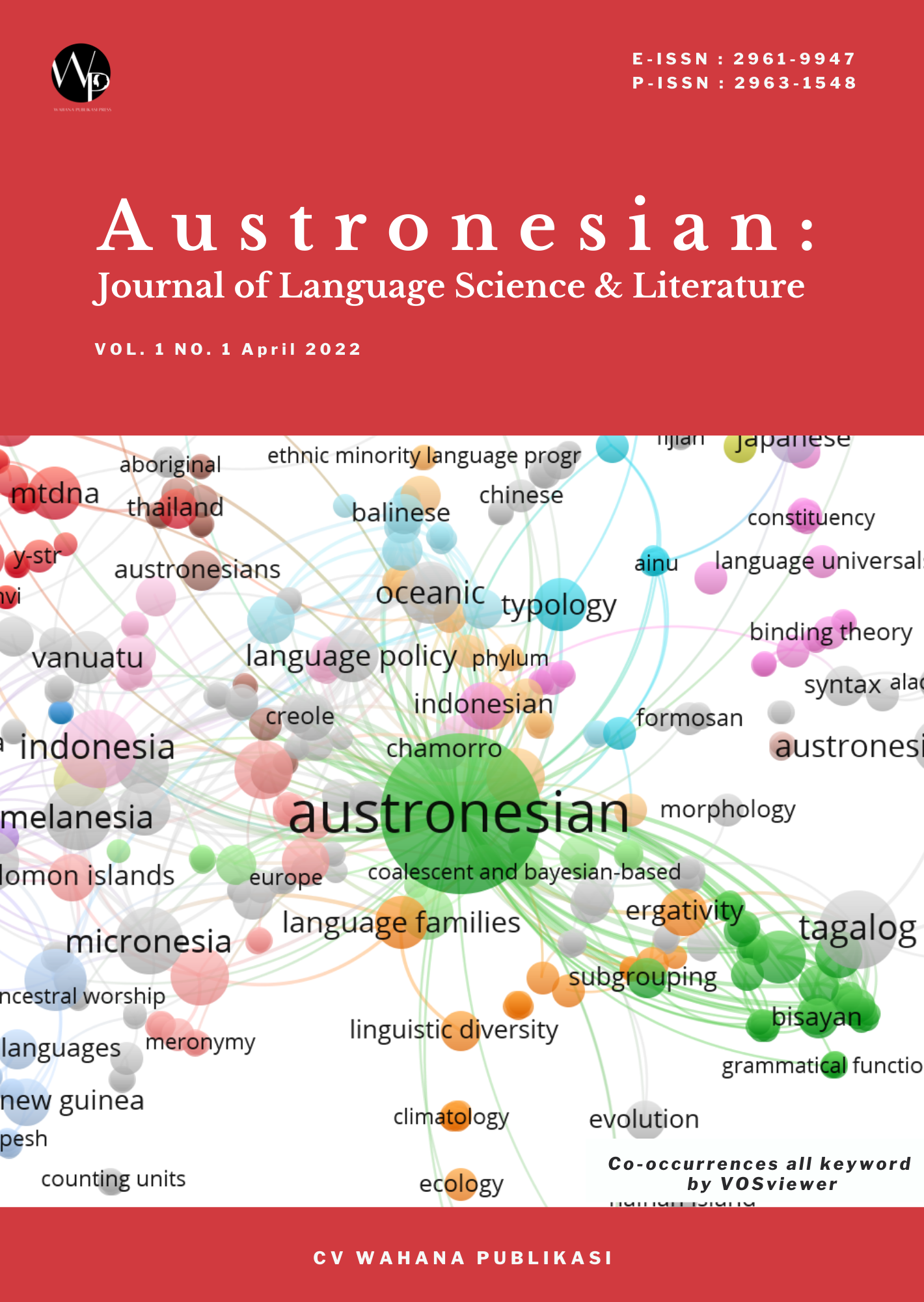Verbal and Non-verbal Signs of “AQUA Life: Care for Nature, Nature Cares for You”
DOI:
https://doi.org/10.59011/austronesian.1.1.2022.38-46Keywords:
Semiotics, Verbal signs, Non-verbal signs, Commercial advertisementAbstract
This study aims to analyze the verbal and non-verbal signs as well as the meaning contained in the “AQUA Life: Care for Nature, Nature Cares for You” Advertisement. This study used a qualitative method. An observation method was used to collect the data. The data were taken from the YouTube platform. In analysing the verbal and non-verbal signs based on the Saussure’s semiotic theory while in analyzing the meaning of the verbal and non-verbal signs based on the Barthes’s theory. In addition, the study of colors was done using the approach of color term submitted by Cerrato. As the result, the researchers found three verbal signs and three non-verbal signs in this advertisement. The advertiser highlighted the advertised product in this advertisement, attempting to persuade the viewers that using 100% recycled products is one of the essential things to protect this planet. Furthermore, this advertisement also emphasized the importance of consuming mineral water for body health. From the analysis, it can be concluded that the “AQUA Life: Care for Nature, Nature Cares for You” advertisement employed meaningful sentences to gain the attention of their target consumers.
References
Agustini, N. K. S., Netra, I. M., & Rajeg, I. M. (2017). Semiotic analysis in Maybelline Lipstick advertisement. Jurnal Humanis, Fakultas Ilmu Budaya Unud, 20(1), 35–41. Retrieved from https://ojs.unud.ac.id/index.php/sastra/article/view/32867
Barthes, R. (1977). Elements of Semiology. New York: Hill and Wang.
Bogdan, R. C., & Biklen, S. K. (2011). Qualitative Research for Education: An Introduction to Theories and Methods (5th ed.). Boston: Pearson.
Cambridge Dictionary, O. (2022). English Dictionary, Translations & Thesaurus. Cambridge: Cambridge University Press. Retrieved from https://dictionary.cambridge.org/
Cerrato, H. (2012). The Meaning Of Colors. New York: Herman Cerrato Graphic Designer. Retrieved from the-meaning-of-colors-book.pdf.
Chandler, D. (2001). Semiotic for Beginners. Aberystwyth: Aberystwyth University Press.
de Saussure, F. (2011). Course in General Linguistics. New York: Columbia University Press.
Dyer, G. (2008). Advertising as Communication. London: Taylor and Francis.
Gilson, & Berkman. (1980). Advertising: Concepts and strategies. Toronto: Random House Business Division.
Marshall, C., & Rossman, G. B. (2015). Designing Qualitative Research (5th ed.). Newbury Park: SAGE Publications.
Meriandari, N. R. A., Candra, K. D. P., & Permana, I. P. A. (2022). Connotative Meaning of Verbal and Visual Signs in What Can’t Milk Do? Advertisement. TANDA: Jurnal Kajian Budaya, Bahasa Dan Sastra, 02(01), 55–63. Retrieved from https://aksiologi.org/index.php/tanda/article/view/322
Pratiwi, D. M. Y. (2022). An Analysis of Verbal and Nonverbal signs in Pantene Shampoo Advertisements. Mahasaraswati Denpasar.
SehatAQUA. (2020). AQUA Life - Redefine Your Normal. [Video]. YouTube, https://www.youtube.com/watch?v=xND4-y1gBbg
Widiarta, I. W. R. (2021). An Analysis of Verbal and Non-verbal signs found in Football Shoes Advertisements. Mahasaraswati Denpasar.
Wierzbicka, A. (1996). Semantic Prime and Universals. New York: Oxford University Press.
Downloads
Published
How to Cite
Issue
Section
License
Copyright (c) 2022 Ni Nyoman Sayun Trinadi, Desak Putu Eka Pratiwi, I Made Perdana Skolastika

This work is licensed under a Creative Commons Attribution-NonCommercial-ShareAlike 4.0 International License.






